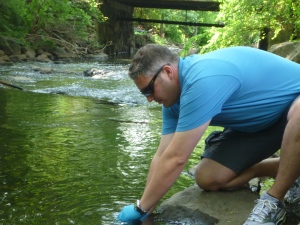Efforts will increase knowledge about water pollution in Westchester, Nassau, and Greenwich
FOR IMMEDIATE RELEASE
Monday, June 29, 2015
CONTACT
Sarah Ganong: 203-787-0646 ext. 128
Mamaroneck, NY – Save the Sound began its summer water quality monitoring season today with eight trained volunteers sampling water on the Long Island Sound shoreline in Westchester and in the Hutchinson River for bacteria that indicate the presence of sewage. Just in time for the Independence Day holiday weekend, Save the Sound will also restart its Sound Swim Alerts, a convenient way for area residents to find out whether beaches are open for swimming or closed due to bacterial pollution.

The non-profit organization, which is a bi-state program of Connecticut Fund for the Environment with offices in New Haven and Mamaroneck, is expanding both programs this year. Volunteers will conduct water quality sampling in Port Chester, Rye, Mamaroneck, Larchmont, New Rochelle, Pelham, Mount Vernon, Harrison, White Plains and Scarsdale, NY, and in Greenwich, CT. The Sound Swim Alerts will expand from Westchester County to include Greenwich as well as Nassau County communities on the Long Island Sound shoreline.
“Bacterial pollution from sewage is a major problem in many of our harbors, bays, and coastal streams—and it poses a serious public health risk,” said Tracy Brown, director of western Sound programs for Save the Sound. “Residents deserve to know whether the water in their town is safe for their kids to play in. And if it’s not safe, residents deserve to know why. Sewer overflows, leaks, and faulty septic systems are often the culprits. Our water monitoring and the watchful eyes of citizens in Westchester have identified several bacteria hotspots over the past several years, and we’ve worked with municipal leaders to make sure they’re cleaned up. The data we collect supports our efforts to get strong plans for clean water at the local, state, and federal levels. We’re excited about bringing that model to more communities.”

Staff will process the samples at Save the Sound’s new lab in Mamaroneck, made possible by an EPA equipment loan. “Our lab enables us to measure the bacteria Enterococcus and E. coli, as well as other factors that influence the health of our waterways such as dissolved oxygen and pH,” said Save the Sound water quality program manager Peter Linderoth. “We’re following an EPA-reviewed protocol to ensure we’re bringing accurate information to the public and to the decision-makers who have the power to clean up our harbors and the Sound.”
Data sets, maps, and analysis of 2013 and 2014 water quality monitoring can be viewed on Save the Sound’s website.
Save the Sound issues its Sound Swim Alerts on weekends and rainy weekdays. Because heavy rains can lead to sewage leaks or overflows from cracked and outdated sewage infrastructure, many beaches around Long Island Sound are preemptively closed after heavy rains (criteria vary from locality to locality). Save the Sound gathers information about beach closings from municipal and county health departments and makes it available via the organization’s email list, blog, Facebook, or Twitter accounts.
“Every year, residents and visitors to New York’s and Connecticut’s shorelines miss out on enjoying our beautiful beaches because of water pollution. We’re committed to making sure every beach is safe for swimming, every day,” said Brown.
###
Save the Sound is a bi-state program of Connecticut Fund for the Environment with an established 40-year track record of restoring and protecting the waters and shorelines of the Sound. From its offices in New Haven and Mamaroneck, Save the Sound works for a cleaner, healthier, and more vibrant Long Island Sound where humans and marine life can prosper year-round. Our success is based on scientific knowledge, legal expertise, and thousands of ordinary people teaming up achieve results that benefit our environment for current and future generations.
